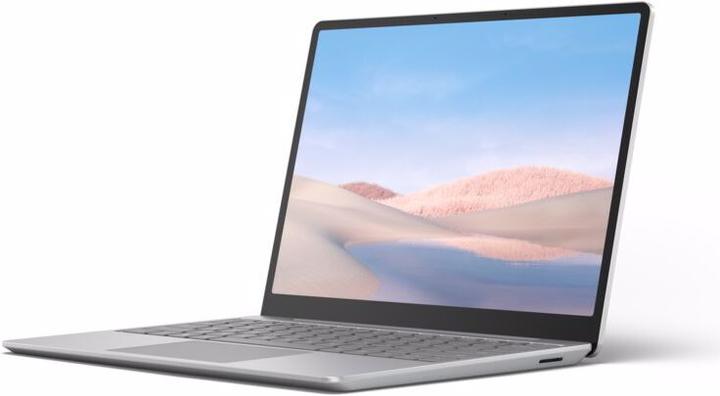

Surface Laptop Go: reviewing Microsoft's smallest notebook to date
Microsoft has launched a 12.4-inch notebook with entry-level features and called it the Surface Laptop Go. It comes with Intel 10th-Gen-i5-SoC, a touchscreen and, at first glance, there’s hardly anything bad to say about it. But will a closer inspection tell us a different story?
With its 12.4-inch touch display, the Surface Laptop Go is reminiscent of the 12.3-inch Surface Pro 7 convertible. But this new entry-level notebook doesn't boast as a high a resolution and isn't as convenient to use. It lacks both a Windows face recognition camera and a backlit keyboard. Apart from that, it seems to be a powerful office device – on paper at least. It even has active cooling, which is something Microsoft forgot to include on the Pro 7 with i5.

The specs on the Sandstone model I'm reviewing:
- Processor (system on a chip): Intel Core i5-1035G1
- Integrated graphics processor: Intel UHD Graphics (Ice Lake G1)
- RAM: 8 GB RAM (SK Hynix H9HCNNNBKMALHR-NEE, LPDDR4-3732, 2 × 4 GB)
- Storage: 256 GB SSD (SK Hynix HFM256GDGTNG-87A0A, M.2 2230 PCIe 3.0 × 4)
- Display: 12.4” IPS multi-touch display (PixelSense Display) with 1536 × 1024 pixels (3:2 aspect ratio, 148 ppi, high gloss)
- Keyboard: no backlight, fingerprint sensor in the power button
- Connections: 1 × USB 3.1 type C, 1 × USB 3.0 type A, Surface Connect charging port.
- Audio: 3.5 mm headphone jack, stereo speakers with Dolby Audio and dual Studio Mics
- Camera: 720p front-facing camera
- Wi-Fi, Bluetooth: Wi-Fi 6, Bluetooth 5.0
- Battery: 39.7 Wh lithium-ion battery
- Operating system: Windows 10 Home in S mode (it's free to switch to «Windows 10 Home»)
- Dimensions: 27.8 × 20.6 × 1.6 cm, 1110 g
- Power supply: 39 W
You can also get the Surface Laptop Go at a relatively low price if you go for the 128 GB SSD version. Microsoft is certainly asking customers to shell out the big bucks for more storage.
And there’s a version on the market that I can't warn you enough against buying. It has a measly 4 GB of RAM and 64 GB of cheap eMMC storage. In theory, the laptops come in the following colours: Platinum, Ice Blue and Sandstone. But in some cases, the Sandstone models aren't available.
Design and ports
It's a handy notebook with the unmistakable Surface-look. The aluminium casing in Sandstone that adorns the 4 mm-thin lid and top of the base looks good and feels accordingly metallic-cool.
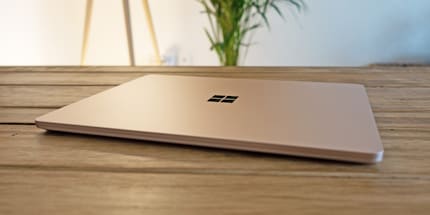
Slightly rubbery, the underside of the base is also pleasant to the touch. When I tap a fingernail against it, the material sounds like hard plastic. According to Microsoft, it's made of a polycarbonate composite system with glass fibre and 30% post-consumer recycled materials.
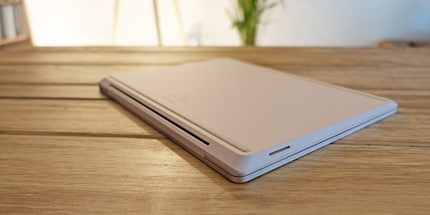
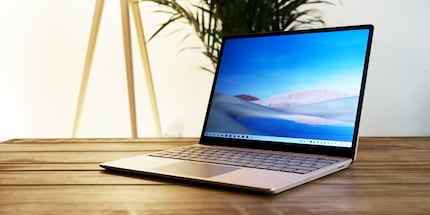
When you open it, you see a display that extends fairly far to the sides and the top. The edge is about 7 mm, which offers enough space for a 720p front-facing camera. The vents for the active cooling system are inconspicuously hidden away in the display hinge above the keyboard. Depending on the light, the aluminium around the keyboard shimmers in a faint pinkish hue. It's not shy to put on a show...
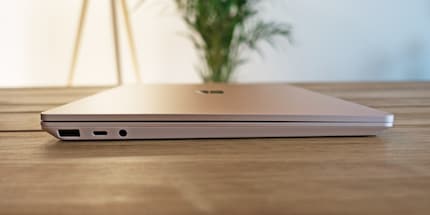
You can find the ports on the left-hand side, and it doesn't take long to count them. Microsoft has treated us to a USB-C and USB-A port as well as a 3.5 mm headphone jack. And that’s it. There aren't any more ports. Not even a micro SD slot. If you want any other connections, it has to be via Bluetooth 5.0 or Wi-Fi 6. The charging port is on the right-hand side in the form of the Surface Connect port.
Touchscreen with rounded display mask
With its aspect ratio of 3:2, the shiny 12.4-inch IPS touchscreen can’t even display 1080p films in native format. But this is barely noticeable unless you do a side-by-side comparison with a reference device. That's because the 1536 × 1024 pixel resolution is too low for 1080p. Still, I'm a little disappointed. I don't think of 148 ppi as up-to-date any more. Certainly not at the current price.

What I notice first about a display is that its image has slightly rounded corners. The display mask crops some pixels, which actually looks quite good. But it still confuses me somewhat and makes me wonder if it's actually useful. Have I seen it somewhere before? Anyway, moving on...
Just as important as the resolution is the evenness of the backlight, its maximum brightness and how exact display colour representation is. I measure all of that with the x-rite i1Display Pro Plus:
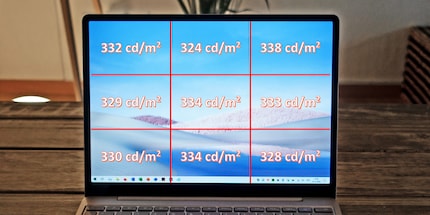
With over 300 cd/m² maximum average brightness – 331 cd/m² to be exact – the display is the minimum brightness I'd expect from a mobile end-user device. That’s enough to work in the shade, even in slightly harsher lighting conditions.
The evenness of the lighting, which is almost perfect, is excellent. There's only 14 cd/m² between the brightest and darkest measurements. That's a minimal difference, which is hardly visible to the naked eye.
Unfortunately, the colour space coverage measured can't keep up with the quality of the lighting. I recorded 93.1% for sRGB. At any rate, this means that at least the pictures you see when surfing and working will mostly be displayed accurately. For the colour space DCI-P3, which is important for video, it's 69%. Adobe RGB is at 67.1%. Based on that, I wouldn't recommend you use the notebook for any image editing work that's destined for print. I calculated a static black and white contrast of 911:1.
Keyboard with no backlight
What's going on, Microsoft? The manufacturer makes up for the lack of face recognition with a fingerprint sensor in the power button, but it leaves us in the dark when it comes to a backlit keyboard. Even if you can touch type.
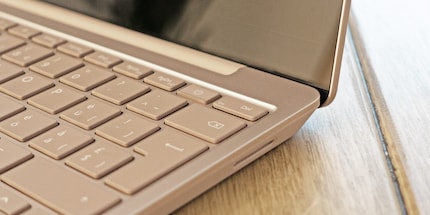
With gentle pressure on the keys, I can feel something rubbery under my fingertips. When I smack my fingers down onto the keys, I sense a clear pressure point as the key begins to move. The key stroke occurs at 1.3 millimetres. It's not long before I'm used to it and typing with speed and precision. All the while, the keyboard is almost inaudible.
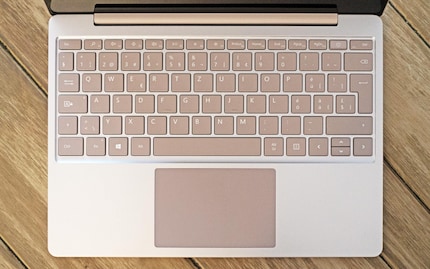
I can't fault anything about this 10 × 6.7 cm trackpad. It feels lovely and smooth, and I can get the pointer to go to the right place quickly. Clicking on the integrated keys is discretely quiet and somehow satisfying. I enjoy pressing around on the trackpad.
Invisible notebook speakers
Microsoft has built in the already well-known Omnisonic speakers under the keyboard. And they’ve improved. The criticism I still had with the Surface Laptop 2 was that the sound was a bit tinny on very high notes. But that's all in the past now. The lows, mids and trebles also sound quite well-balanced, even though the bass isn't very boomy.
What's still problematic is tougher sounds. Guitars in metal, rock or industrial music sound more subdued and distant, for example in «Wurstwasser» by «Mundstuhl».
Incidentally, it's a shame you can only get the Wurstwasser song in 240p.
Battery performance with Wurstwasser and Meat Loaf
A few questions need answering. For a start, how long can the Microsoft notebook play Wurstwasser on repeat? How will the CPU and the battery cope with the demands of peak performance? And will the laptop be able to get through an on-the-go office day on one battery charge?
Nonstop YouTube streaming
It goes without saying that I'm not just going to be streaming Wurstwasser. Now and then, there's a clip from Meat Loaf in the mix. I stream YouTube videos at 150 cd/m² display brightness on repeat until the notebook has had enough.
After six hours and seven minutes, it automatically shut down. That kind of performance isn't shabby at all. To give you a comparison, the Surface Pro 7 also features a 10th generation i5 SoC (system on a chip) and boasts five more watt-hours. And yet, it only managed to run for 5 hours and 16 minutes on the same test.
Battery life, CPU performance and volume at maximum performance
In order to see how the battery and the Intel Core i5-1035G1 SoC with active cooling performed at maximum stress, I ran HeavyLoad and FurMark simultaneously at the highest brightness setting.
A minute after the start, I hear a faint noise from the fans. After two minutes, it gets a bit louder and stays at that volume until the end. When I'm sitting down about an arm's length away, the sound measures 43 dB, which is the equivalent of a quiet neighbourhood.
The CPU performance remains at 100% for the time being, which is a good sign. After 14 minutes, it starts to leap about – now the performance fluctuates between 91 and 99%. 12 minutes later, the CPU throttles at 86 to 94%. And that's where it stays until it's regulated down for the last time after an hour and three minutes. At that point, the performance is at 86% and jumps down to 66% twice a minute for about four seconds before shooting back up. After two hours and eight minutes, the battery has run out.
For this test, it's really only of secondary importance how long the device lasts. What's more important is how well the processor is cooled. And I have to say, I'm pleased with Microsoft on that point. The Laptop Go provides 100% performance for almost a quarter of an hour before remaining above 86% with slight dips. If I compare that with other Microsoft devices, such as the three Surface Book 3s I tested, the passively cooled i5 version already starts throttling to around 50% of CPU performance after 34 seconds. Meanwhile, the actively cooled i7 notebooks start to turn down after one or five minutes. 30 minutes later, they're at 70% and finish with about 50% performance.
Battery life with office work
If I don't play YouTube in the background while I'm working on office tasks, and avoid lengths video calls, the battery lasts nine hours.
CPU and graphics processor
The quad-core Intel i5-1035G1 SoC was launched in the third quarter of 2019. It's part of the Ice Lake U generation, making it one of the first processors to be manufactured using Intel's (2nd generation) 10 nm process. It was designed for mobile use in notebooks or convertibles and comes with a 15-watt thermal design power (TDP) as standard. However, this can be configured between 13 and 25 watt depending on the manufacturer. The current version clocks 1 to 3.5 GHz when two cores are used. When all four are used (8 threads), it clocks 3.2 GHz.
The chip also has Intel UHD Graphics G1, which runs at 300 MHz and has a maximum dynamic frequency of 1.05 GHz. What's more, the SoC includes Wi-Fi 6 and AI hardware acceleration.
Performance: what the CPU and GPU are capable of
After the stress test, the CPU and GPU can have at it again. I use the Cinebench R20 and Geekbench 5 benchmarks, primarily to test processor performance. The weakly integrated GPU can show what it’s capable of in the 3DMark Night Raid benchmark. Meanwhile, PCMark 10 lets us simulate and test typical office tasks.
Cinebench R20 and Geekbench 5
Cinebench by Maxon lets you see how your PC performs when rendering Cinema 4D content. Processors with more cores will always deliver better results (except single-core results).
Geekbench runs on Windows, MacOS, Linux, Android and iOS. As well as simulated real scenarios that test the CPU (single- and multi-core), Geekbench can also detect your GPU performance when it comes to image processing and machine vision. Thanks to the Geekbench Browser, you can compare the results with other systems.
Here are the test results:
| Results:
Surface Laptop Go | Results:
Surface Pro 7 (i5) | Results:
Surface Book 3 (i5) | |
|---|---|---|---|
| Cinebench R20 – CPU Multi-Core | 1136 points | 1504 points | 1167 points |
| Cinebench R20 – CPU Single-Core | 399 points | 361 points | 395 points |
| Geekbench 5 – CPU Multi-Core | 3456 points | 4430 points | 3400 points |
| Geekbench 5 – CPU Single-Core | 1153 points | 1230 points | 1065 points |
| Geekbench 5 – GPU OpenCL
(graphics benchmark) | 5494 points | 7515 points | 8283 points |
| Geekbench 5 – GPU Vulkan
(graphics benchmark) | 4858 points | - | 8092 points |
It gives you another opportunity to compare the Surface Pro 7 and the Book 3. That's why they're also included in the table. In the i5 versions, they have an almost identical SoC: the i5-1035G4 and the i5-1035G7 with a 100 and 200 MHz base frequency, respectively. The reason these only manage to score better than the current SoC in shorter benchmarks is probably the lack of cooling. The Laptop Go fares better in Cinebench R20's longer, single-core benchmark than both of the other models.
Gaming benchmark: 3DMark Night Raid
I use 3DMark's Night Raid to test out gaming on the lowest level. This DirectX 12 Benchmark is intended for mobile end-user devices with an integrated GPU.
The Laptop Go scores 6801 points, making it lag slightly behind an average office notebook of the year with Intel Iris Pro Graphics and i7-1065G7 – the i7 reference model ratchets up 9408 points.
Office benchmark: PCMark 10
Thanks to 3DMark's PCMark 10, you can test PCs and notebooks in various tasks around your workplace. It’s an office benchmarking software great for any device with a weak GPU.
With 3317 points, the Laptop Go is once again a far cry from the i7 reference model listed above, which scored 4611 points. Nevertheless, the current notebook is well-equipped for all office-related tasks. It's even capable of a bit of Photoshop, as long as you're OK with imperfect Adobe RGB rendering.
Verdict: a well-cooled i5 device with sleek features
Finally, a Microsoft i5 device with active cooling. Nice one.
Just as worthy of praise is the fantastic design, as well as the fact that the laptop can easily handle all office situations and that the touchscreen looks evenly lit and bright. Similarly, I can't find any fault with the trackpad or keyboard. Well, hardly any fault. The lack of backlighting on the keyboard is still a source of frustration.
Not as laudable is the low, but still sufficient, 1536 × 1024 pixel resolution. In addition, there aren't enough ports and the 256 GB disk space unfortunately costs a lot compared with other models.
Despite the fact this notebook has a certain charm and does serve a purpose, I'd only buy it if I had my heart set on a Surface notebook. After all, other manufacturers offer better devices at cheaper prices.
I find my muse in everything. When I don’t, I draw inspiration from daydreaming. After all, if you dream, you don’t sleep through life.

